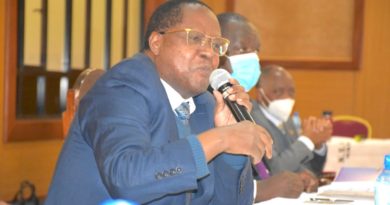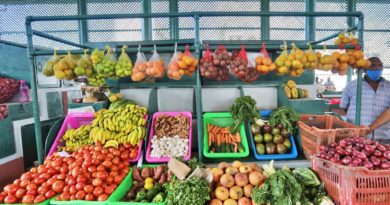Kenya and India Explore Increased Connectivity Through the Indian Ocean
Speech by Amb. Amina C. Mohamed, Cabinet Secretary for Foreign Affairs and International Trade During the Seminar on “Connectivity Revisited: India, Kenya and the Indian Ocean”, Nairobi.
Ladies and Gentlemen,
I thank H.E Suchitra Durai for organizing this seminar on the crucial theme of ‘Connectivity Revisited: India, Kenya and the Indian Ocean.’ I am grateful to the organizers for the invitation to be part of the conversation on this subject which is particularly pertinent to Kenya and India.
As members of the Indian Ocean Rim, Kenya and India therefore benefits immensely from the Indian Ocean connection at the epicenter of global trade and commerce. In fact, thanks to the Indian Ocean, our blue economy has and remains critical to the overall growth of our economies and the sustainable development of our two countries.
The theme of this seminar is therefore very crucial for us in terms of identifying ways and means of enhancing this connectivity so that goods and services can move at faster speeds, in greater volumes and numbers, at lower costs and in safe and secure waters; while at the same time ensuring that maritime resources are harnessed efficiently.
Excellencies, Ladies and Gentlemen,
Over the years, India has become an important political, economic and social partner to Kenya. Our shared history and experiences form an important foundation of our present partnership; from our rich culture to similar foods such as Chapati, Samosa and Ndengu have become famous delicacies in Kenyan cuisine!
Although Diplomatic relations were established in the early 1960s with the establishment of resident diplomatic missions in both Nairobi and New Delhi, relations between India and Africa have been in place for hundreds of years, dating back to the First Century AD. Trade between India and the African continent through the Indian Ocean brought us together long before the existence of modern-day civilization.
India contributes largely to the nationhood of Kenya. We must therefore look past the artificial enclaves that have labeled our differences and focus instead on nationhood and the collective contributions made to our great country.
The Indian Ocean trade has been a key factor in East – West exchanges throughout history. Long distance trade in dhows and sailboats made it a dynamic zone of interaction between peoples, cultures, and civilizations stretching from Java in the East to Zanzibar and Mombasa in the West. It is interesting to note that cities on the Indian Ocean rim were two-faced. They looked outward to the sea as much as they looked inward to the hinterland.
These historical links have overtime crystallized into a solid foundation for cooperation between Kenya and India across a wide range of sectors.
Our cooperation in areas such as human resource development, healthcare, peace and security have matured. Today, India provides us with a contemporary development experience which can be emulated in our own situations.
Kenya is therefore a natural partner for India and looks forward to expanding frontiers of cooperation including on enhancing connectivity along the Indian Ocean.
Excellency, Ladies and Gentlemen,
The Indian Ocean region has rapidly emerged as an essential crossroads linking the world’s major producers and consumers of natural resources.
Today, around 100,000 vessels pass through the Indian Ocean region annually, more than two-thirds of the world’s oil passes through the region’s waters while 40% of the world’s offshore oil production comes from the Indian Ocean. A time has now come when the natural riches beneath the sea have become as crucial to securing the region’s future welfare as the wealth travelling over the ocean waves.
Today, the Indian Ocean’s living resources represent one of the region’s most significant assets. According to the United Nations Food and Agriculture Organization (FAO), the East Indian Ocean alone is home to almost half of the world’s fisheries and yields around 8 per cent of global fish production. AAs a whole, Indian Ocean fisheries have soared from less than 900,000 tonnes in 1950 to 11.3 million tonnes in 2010, about 14.6 percent of the world’s catch. Aquaculture has expanded equally rapidly, growing twelve-fold globally since 1980. In 2010, six Indian Ocean nations – India, Indonesia, Bangladesh, Thailand, Egypt, and Myanmar – counted among the top ten producers worldwide, supplying over 11.3 million tonnes of fish between them, as much as all the region’s capture fisheries combined.
The Indian Ocean, it seems, is the gateway to our collective development and prosperity.
Excellencies, Ladies and Gentlemen,
Challenges in enhancing connectivity abound, however. Greater connectivity, for example, takes more than new ‘hardware’ of roads, rails, ports and telecommunications. It also requires better infrastructure ‘software’ – which means appropriate regulatory frameworks, more capable institutions, and better-networked businesses and people. In seeking greater connectivity, it is important that we reflect on the way forward with respect to the ‘software’ dimension of infrastructure.
Secondly, increased connectivity demands closer cooperation in other areas – especially maritime security and environmental protection.
We must, in particular reflect on the sustenance of collaborative efforts in combating transnational maritime crimes such as piracy, illegal fishing, and drug trafficking – the proceeds of which are sometimes committed to financing terrorism.
These maritime security and environmental challenges affect all the countries on the Indian Ocean region and can best be tackled through cooperation. It is therefore important to emphasize cooperation bearing in mind the words of former United States President Barack Obama, that ‘in an interconnected world, we all rise and fall together.’
Finally, it is important that we address the financial dimension of greater connectivity. Enhanced connectivity demands infrastructure, and infrastructure demands investment. Moreover, harnessing the economic benefits of the Indian Ocean – from fisheries and tourism to energy and transportation – requires investments in environmental protection and sustainability.
These investments require financial resources, which must be mobilized not just from Kenya and India but also from other stakeholders.
In conclusion it is my hope that this seminar will focus on this theme in all these broad dimensions with a view to offering practical ideas on how we can collectively and constructively utilize our shared resources for the benefit of our people.
I would like to express Kenya’s pride in the entrepreneurship, dynamism and patriotism of the Indian Community in Kenya.
I wish you all fruitful deliberations.
I thank you.



